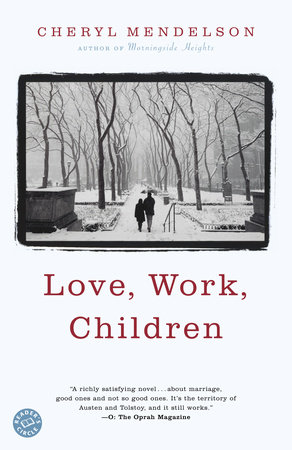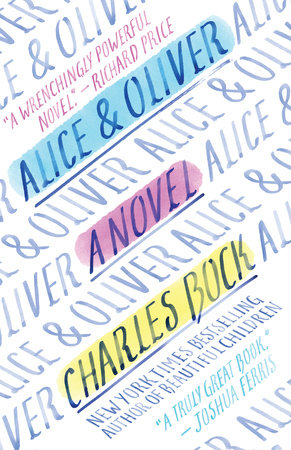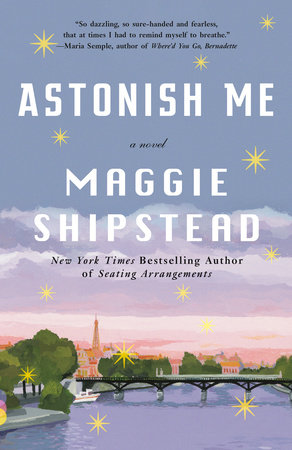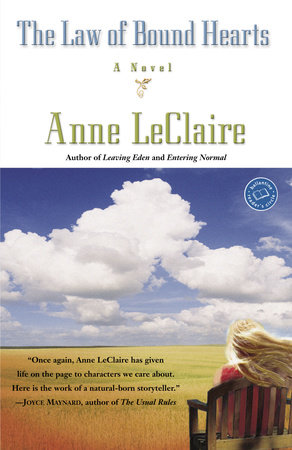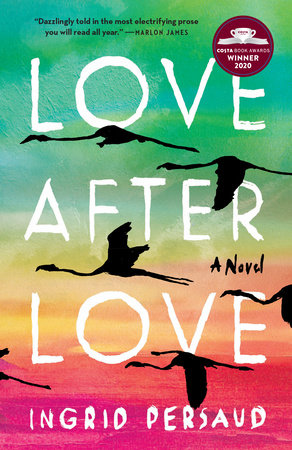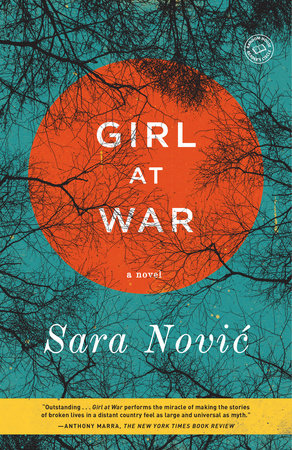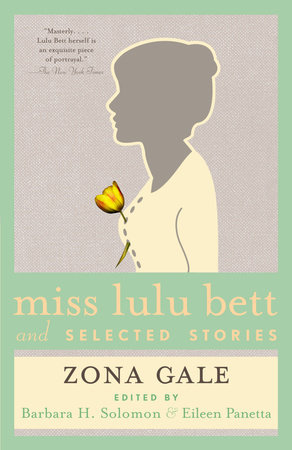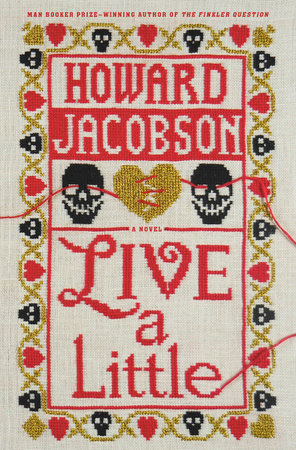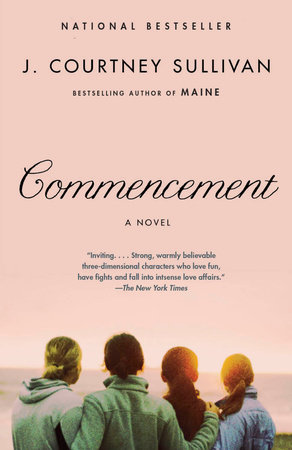An Interview with Cheryl Mendelson
Random House: What was the book that most influenced your life or your
career as a writer—and why?
Cheryl Mendelson: Many books have mattered enormously to my life and
work. David Copperfield by Charles Dickens would be one of several
contenders for “most influential.” I first read it when I was thirteen
and have reread it dozens of times since. Both the story—of a child
struggling alone and unaided, against frightening obstacles, to make
his way in the world—and Dickens’s way of telling the story became
templates in my mind, the one for living and the other for writing.
RH: What are your ten favorite books, and what makes them special to
you?
CM: My list of favorites is alphabetized so as to avoid the appearance of
ranking. There are easily another thirty books I like as well as these,
many by some of the same authors. I like all these classics of English,
German, and Russian fiction for the same reasons: because they are
works of the moral imagination, their characters and societies
can matter deeply to me, and the person who tells me all about these
people and places, the author, is the best company in the world—
someone intelligent, compassionate, passionate, and remarkably
skilled in observation, description, and narration.
Austen, Jane. Emma
Dickens, Charles. David Copperfield, Great Expectations
Dostoyevsky, Fyodor. The Brothers Karamazov, The Idiot
Eliot, George. Middlemarch
Hardy, Thomas. Jude the Obscure, The Return of the Native
Mann, Thomas. Buddenbrooks
Tolstoy, Leo. Anna Karenina
When I read nonfiction, I favor political and social analysis, like
Thomas Frank’s What’s the Matter with Kansas? or Jared Diamond’s Guns,
Germs, and Steel.
RH: What types of music do you like?
CM: I listen to lots of music, especially Bach, opera (all periods), German
lieder, chamber music, and rock, old and new.
RH: If you were part of a book club, what would the group be reading, and
why?
CM: I’d like to read Jared Diamond’s new book, Collapse: How Societies Choose
to Fail or Succeed, which is about how various societies have destroyed
themselves through ecological and social irrationalism. I read an extract
about Easter Island that was as riveting as a crime thriller. The
book sounds like it’s full of things we all should know. I’m also a big
fan of Alexander McCall Smith, and I imagine that his new book,
Friends, Lovers, Chocolate, would be fun to share.
RH: What are your favorite kinds of books to give—and get—as gifts?
CM: To intimate friends, I give novels. When I know people’s taste less well,
I try to give them something brand-new (so I can be sure they don’t
have it yet) on a subject that interests them—like gardening or the
Civil War or French antiques. I myself love getting cookbooks and
novels that some congenial person has already tried and liked.
RH: Do you have any special writing rituals? For example, what do you
have on your desk when you’re writing?
CM: First, I go to a stationer’s and buy two notebooks, a larger hard-backed
one for writing sketches, ideas, and outlines, and a smaller soft-backed
one for carrying around with me, in bag or pocket, in case of sudden
flashes of thought. They must be narrow-ruled, and I write entirely in
pencil—unless I’m really desperate. I’ve usually gotten lots of material
into these by the time I sit down to the desk. On the first day at the
computer, my desk is pristinely neat, with a fresh notepad, sharpened
pencils, and maybe even a bud vase with some actual buds. I create a
new directory on my computer and update my word processor and
consider, again, buying a faster printer. (I always decide not to.) This
orderly state of affairs lasts for at least several hours. Then the chaos
and irrationality of the process take over, and I don’t reorder things
until a first draft is complete—maybe a year later. All these little rituals
aspire to control and order a process that is frighteningly uncontrollable,
and they are completely absurd.
RH: Many writers are hardly “overnight success” stories. How long did it
take for you to get where you are today? Any rejection-slip horror stories
or inspirational anecdotes?
CM: I published only in academic journals in philosophy until I was in my
forties, but I had been writing fiction and poetry my whole adult
life—without ever once trying to publish it, and rarely letting anyone
read it. I burned my first novel, page by page, in a fireplace. A couple
of others got thrown into the back of file cabinets and forgotten. My
style and motifs changed dramatically from the time of my twenties
until 2003, when I first published fiction. When I finally decided to
try to publish nonacademic things, I was surprised that each book succeeded
practically immediately. This still astonishes me. I’m not sure
anyone could try to imitate this, as it all happened unplanned. But it
should encourage people who are hoping for a late start.
RH: Give us three “good to know” facts about you.
CM: I was born and raised (until age thirteen) in Appalachian southwestern
Pennsylvania, on a dairy farm outside a little mining town—a
company town, where I went to school with the miners’ children.
When I saw New York City as a child, I fell in love with the place and
vowed to get there someday, and finally did. But I feel like an immigrant,
even in this city full of people from somewhere else and even in
my own small circle. My differences from the people I know here are
far greater than theirs from one another, from their point of view as
well as my own. (It would take a book to explain how and why.)
RH: What else would you like your readers to know?
CM: I’m a walker. I take long walks—miles and miles, with iPod, small
notebook, and pencil. I play the piano. Along with the rest of my family,
I am a film fanatic. We spend astonishing amounts of time researching
which films we’ll watch on weekends at home.
RH: What are some of your favorite films, and what makes them unforgettable
to you?
CM: The Seventh Seal evokes a childish terror of death and uses it to expand
the viewer’s moral compass, to make us more compassionate, more admiring
of small acts of courage, more grateful.
Casablanca is a favorite, even though I don’t esteem it enormously
highly as cinematic art. What interests me about it is how contemporary
this story of love and courage and sin in a world of increasing
horror is. It creates a style for dealing with these things which is equal
parts cool, humor, and seriousness and which does not feel even remotely
dated, even though, being upwards of fifty years old, it should
feel dated and (I hope) someday will.
I love the Matrix trilogy and discovered that I can happily rewatch
these films as often as my adolescent son does. What fascinates me
about them is the premise that inner (psychological) events can solve
outer (social and political) problems—even though it’s an idea I’m
deeply skeptical of. The fascination, I think, comes from a real-life
sense of helplessness in the face of the things that are wrong with the
world.
RH: What are you working on now?
CM: I’ve just finished the third novel in my Morningside Heights trilogy.
RH: What are some of the challenges involved in writing a trilogy?
CM: Aside from the obvious ones of maintaining consistency over a triply
wide span of characters, scenes, and motives, there is also the fact that
more time goes by and things change as time passes—not only the author
and her moods and ideas, but the world too. This particularly
matters when you’re writing about real places, as I have been in the
Morningside Heights trilogy. The first volume was written in 2000–
2001, and Random House offered to publish the book in August
2001. We shook hands and went on summer vacation, intending to get
down to the work of preparing the manuscript for publication after
Labor Day. In the interim, of course, came September 11. I first spoke
with my editor about the novel when we were all grieving deeply, and
dust clouds still hung over lower Manhattan. This tragedy profoundly
affected our attitudes—and readers’ too, I’m sure. Suddenly, Morningside
Heights was about a New York that was gone.
RH: Did September 11 affect Love, Work, Children too?
CM: September 11 contributed a strain of darkness to Love, Work, Children,
despite the fact that the book is a comedy and ends happily. You see
this in the characters’ sense of threat from the world outside the city
(a reverse of the tradition that saw the city itself as the threat) and in
the murderous rage that is depicted in all the book’s relations—
intimate, social, and political. Real New Yorkers, mourning the
deaths of thousands of innocent neighbors and trying to fathom the
rage that led to their murders, were stunned to hear these crimes
described, with considerable satisfaction, by both radical fundamentalist
Christians in the United States and Islamists abroad, as punishment
for our sins. Through characters who are all given very specific
and realistic histories, psychologies, and societies, Love, Work, Children
explores the universal feelings of exclusion, inferiority, and humiliation
that led to this kind of rage in so many contexts, rage with the
potential to issue in murder or in cruel attempts to re-create those
painful feelings in others.
RH: Are your characters based on real people? Where do you get them? Do
you have favorites?
CM: I am always asked this, and I have no adequate answer. My characters
are not based on real people, although occasionally (not typically) I
draw on real incidents. They come into my head all by themselves,
feeling very real, with complicated psychologies and life histories.
When they are written up and a book is done, sometimes I see resemblances
between characters and people I know, and sometimes I don’t.
Like many other authors, I become deeply attached to my people, miss
them when I have to pay attention to other things, and mourn them
when I move on. And they are like my children. I love them all, even
the unlovable ones.
RH: Do any of the characters in Love, Work, Children reappear in the third
volume of the trilogy?
CM: Yes, indeed. The Braithwaite family and Peter Frankl play prominent
roles in the last book. There are also appearances by other characters
from the first volume. Greg Merriweather has a central role in number
three, and Morris and Merrit and Jonathan and Lily appear briefly.
382 A Reader’s Guide
